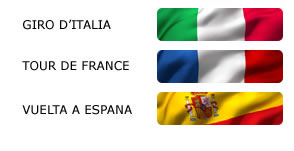
The week of national championships brings to light the story of a decidedly unusual French champion. It was a long and varied competitive cycling career that Marcel Tinazzi experienced. Long and eventful, with a path, especially in his early years, that stands out in his "curriculum/palmarès" where the highlight is the national professional road champion jersey conquered in 1977. However, it's not our white-red-green tricolor, but the blue-white-red of France.
Following the chronological order, we recall that Marcel Tinazzi was born in Meghnia, in the northern part of Algeria, almost at the border with Morocco and close to the Mediterranean Sea, on November 23, 1953.
Tinazzi's father, also a cycling enthusiast, was the brother of Veronese Giorgio Tinazzi (1936-1982), a good professional rider from 1958 to 1962 who rode for San Pellegrino, Mondia Torpado, Ignis, San Pellegrino again, and finally the Swiss Cynar, with various successes in his palmarès.
Marcel's father, Carlo, in the post-war period, enlisted in the Foreign Legion and was stationed in Sidi Bel Abbes, a location that was the historic headquarters of the French Foreign Legion from 1931 to 1961.
And Carlo married Delphine, whose family had composite origins spread between Spain, France, and Italy and had been living in the Meghnia area since around 1830.
And Marcel recalls that his father would wait every day for a copy of Gazzetta dello Sport which would arrive about five days after publication by postal steamship. The internet, with its immediacy, was far from existing, but the news, especially cycling news, was plentiful and "almost" fresh. An habit later shared by young Marcel.
Through the pink newspaper, the father felt a bit at home and followed his brother Giorgio's professional career.
In 1958, with the political upheavals affecting Algeria and other neighboring nations in the French orbit at the time, first the father, followed in 1962 by the entire family, moved to France, to Marseille, the populous port city on the Mediterranean, a vibrant crossroads of diverse humanity from multiple origins and cultures.
And young Marcel became increasingly "taken" with the passion for bicycles and began racing with Excelsior Club, an amateur-oriented society, and then with PSCV of Marseille, training on the famous track that was dismantled during the presidency of OM "Olympique Marseille" by the controversial magnate Bernard Tapie, entrepreneur and politician, already patron of the important cycling team La Vie Claire, centered on Bernard Hinault and Greg LeMond, active from 1984 to 1992.
His career in minor categories suggested, with the support of results, an interesting development in the major professional category.
The transition occurred in the 1977 season with Marcel Tinazzi recruited by the "red devils" of Flandria, a top-level international team on road and track from 1959 to 1979, directed by Flemish guru Alberic "Briek" Schotte, two-time world road champion and winner of northern classics in his cycling career, defined as "the last of the flandriens" for his stubborn character on the bike despite his very small physical build. He embodied and celebrated the Flemish passion for two wheels. And Tinazzi found teammates including the Irish Sean Kelly and Freddy Maertens. In the technical management staff was also the Frenchman Jean De Gribaldy, former cyclist from Besançon, known as "the Viscount", who discovered Sean Kelly and various other notable riders. He was a technically charismatic and astute manager.
He then returned to France, to the famous historic Peugeot with the black and white checkered jersey, guided by Maurice De Muer for the 1979-80 period, then moving from 1981 to 1983 to Sem-De Gribaldy-France Loire created and led by the "Viscount" De Gribaldy.
In 1984 he raced as an "independent" and held the position of UNCP president, the union of French professional riders, the French equivalent of our ACCPI.
His last season in a team was 1985 with Fagor, directed at the time by the unfortunate Luis Ocana. The most important successes, beyond the French national title, were the Tour de l'Aude and Bordeaux-Paris, a historic and long race with multiple stages to be pedaled behind derny.
The web presents the details of Marcel Tinazzi's victories and placements.
After ending his cycling career, he began working in cycling clothing in France, but the turning point, both in life and professionally, came about thirty-five years ago, during his frequent returns to Veneto, when he met Edy, who became his wife, with significant experience and skills in clothing. And in Riese Pio X, in the Castelfranco area, province of Treviso, beneficially affected by a lasting "condition" - better called passion - for cycling nurseries and events for all categories, the MS-Tina Clothing Workshop was born and grew with a diversified clientele in Italy and abroad.
Every year, during the Giro d'Italia in the Marca territory, there is, by tradition, a sort of "reunion" with old Flemish, French, and Italian teammates that combines cycling, memories, and gastronomic specialties, in joy, often at the Fior di Salvarosa restaurant in Castelfranco Veneto, an important hub of Italian cycling for several decades.
With the "gypsy of Eeklo", namely the eclectic Roger De Vlaeminck, toasts of various kinds with the traditional Flemish "prost", derived from "prosit", good luck, escape any quantification while Marcel Tinazzi, with his Italian with a slightly Venetian accent and French nuances, renews shared memories to those present.
